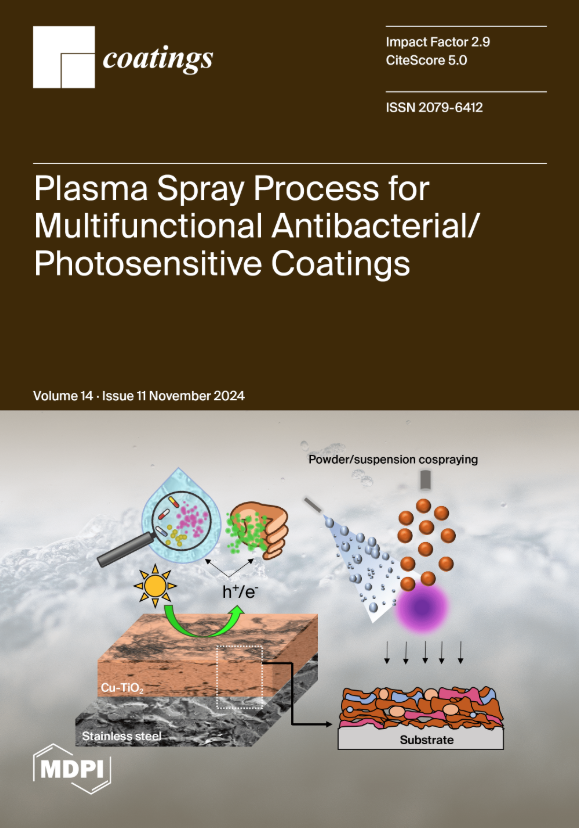Effect of Trace Elements on the Thermal Stability and Electrical Conductivity of Pure Copper
IF 2.8
3区 材料科学
Q2 MATERIALS SCIENCE, COATINGS & FILMS
引用次数: 0
Abstract
Abstract: The impact of introducing trace transition elements on the thermal stability and conductivity of pure copper was examined through metallographic microscopy (OM), transmission electron microscopy (TEM), and electrical conductivity measurements; the interaction between trace transition element and trace impurity element S in the matrix was analyzed. The results show that the addition of trace Ti and trace Cr, Ni, and Ag elements significantly enhances the thermal stability of the pure copper grain size. After high-temperature treatment at 900 °C/30 min, the grain sizes of Cu, Cu-Ti-S, and Cu-Cr-Ni-Ag-S were measured and found to be 200.24 μm, 83.83 μm, and 31.08 μm, respectively, thus establishing a thermal stability ranking of Cu-Cr-Ni-Ag-S > Cu-Ti-S > Cu. Furthermore, the conductivities of pure copper remain high even after the addition of trace transition elements, with recorded values for Cu, Cu-Ti-S, and Cu-Cr-Ni-Ag-S of 100.7% IACS, 100.2% IACS, and 98.5% IACS, respectively. The enhancement of thermal stability is primarily attributed to the pinning effect of the TiS and CrS phases, as well as the solid solution dragging of Ni and Ag elements. Trace Ti and Cr elements can react with S impurities to form a hexagonal-structure TiS phase and monoclinic-structure CrS phase, which are non-coherent with the matrix. Notably, the CrS phase is smaller than the TiS phase. In addition, the precipitation of these compounds also reduces the scattering of free electrons by solute atoms, thereby minimizing their impact on the alloy’s conductivity.微量元素对纯铜热稳定性和导电性的影响
摘要:通过金相显微镜(OM)、透射电子显微镜(TEM)和电导率测量,研究了引入痕量过渡元素对纯铜热稳定性和电导率的影响;分析了基体中痕量过渡元素和痕量杂质元素 S 之间的相互作用。结果表明,添加痕量 Ti 和痕量 Cr、Ni 和 Ag 元素可显著提高纯铜晶粒的热稳定性。在 900 °C/30 min 高温处理后,测量发现铜、Cu-Ti-S 和 Cu-Cr-Ni-Ag-S 的晶粒大小分别为 200.24 μm、83.83 μm 和 31.08 μm,从而确定了 Cu-Cr-Ni-Ag-S > Cu-Ti-S > 铜的热稳定性排序。此外,即使添加了微量过渡元素,纯铜的电导率仍然很高,Cu、Cu-Ti-S 和 Cu-Cr-Ni-Ag-S 的记录值分别为 100.7% IACS、100.2% IACS 和 98.5% IACS。热稳定性的提高主要归功于 TiS 和 CrS 相的钉扎效应,以及 Ni 和 Ag 元素的固溶拖曳作用。痕量钛和铬元素可与 S 杂质反应形成六方结构的 TiS 相和单斜结构的 CrS 相,它们与基体不相干。值得注意的是,CrS 相比 TiS 相小。此外,这些化合物的沉淀还减少了溶质原子对自由电子的散射,从而将其对合金导电性的影响降至最低。
本文章由计算机程序翻译,如有差异,请以英文原文为准。
求助全文
约1分钟内获得全文
求助全文
来源期刊

Coatings
Materials Science-Surfaces, Coatings and Films
CiteScore
5.00
自引率
11.80%
发文量
1657
审稿时长
1.4 months
期刊介绍:
Coatings is an international, peer-reviewed open access journal of coatings and surface engineering. It publishes reviews, research articles, communications and technical notes. Our aim is to encourage scientists to publish their experimental and theoretical results in as much detail as possible. There is no restriction on the length of the papers. Full experimental and/or methodical details must be provided. There are, in addition, unique features of this journal:
* manuscripts regarding research proposals and research ideas will be particularly welcomed
* electronic files or software regarding the full details of the calculation and experimental procedure - if unable to be published in a normal way - can be deposited as supplementary material
 求助内容:
求助内容: 应助结果提醒方式:
应助结果提醒方式:


